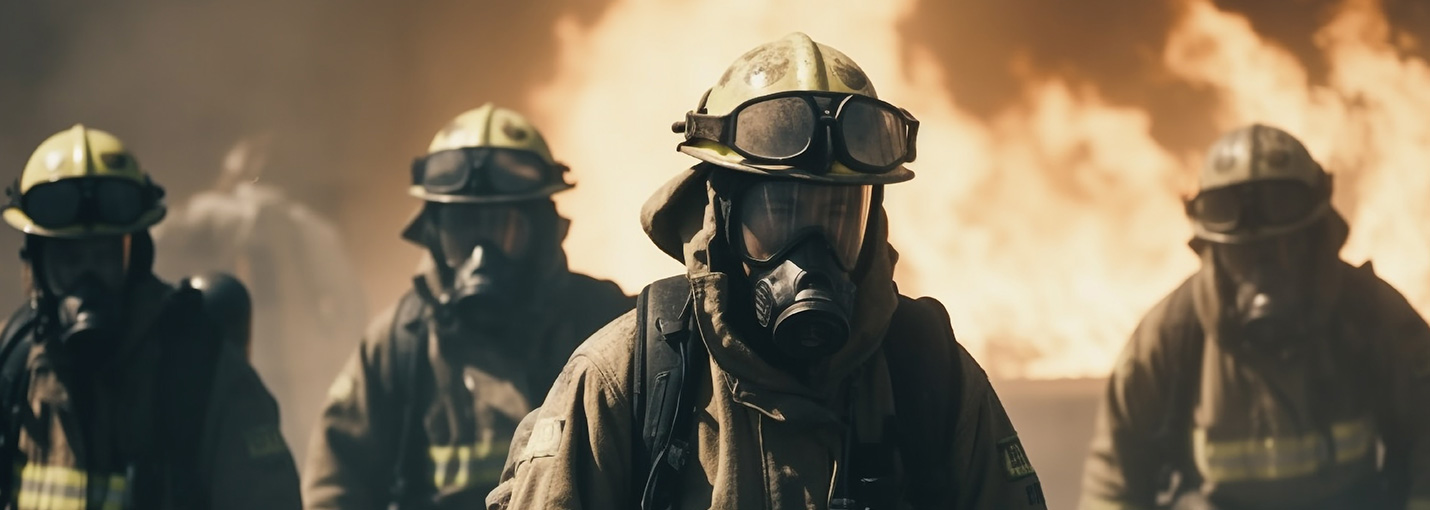Asbestos is a group of naturally occurring silicate minerals with a fibrous structure composed of microscopic fibers. For sake of simplicity, these minerals are all grouped together under the term ‘asbestos.’
!
If you may have been exposed to asbestos, speak with your healthcare provider about tests and screening to help detect the presence of asbestos fibers and asbestos-related diseases.
Asbestos has been used as protection against fire since ancient times.
From cremation shrouds to roofing felt to fire blankets, humans wove asbestos fibers into fireproof cloth.
  |   |   |
Asbestos has been in use for thousands of years but only became popular in the late 1800s. That’s thanks to its insulating and fire-retardant properties, making it a handy to-go in various industries, including construction, shipbuilding, automotive parts, and other manufacturing fields. It has found its way into building materials, brake pads, electrical equipment, and textiles, just to name a few.
Asbestos is sneaky, and it’s easy for its fibers to break up into particles small enough to get airborne and inhaled, wreaking havoc on one’s health in the process. Ultimately, its downside is its elusive taste or smell, so when inhaled or swallowed, a person has no way of knowing they’re in danger.
“The overall evidence suggests there is no safe level of asbestos exposure.”Source: National Cancer Institute (NIH)1 |
Health Problems Associated with Asbestos Exposure
Asbestos exposure is a significant health concern due to its potential to cause several serious illnesses, including lung cancer, mesothelioma, and asbestosis. These illnesses were first linked to asbestos exposure in 1928, when it was discovered that inhaling asbestos fibers could cause asbestosis, which was later found to result in lung cancer.
Symptoms of asbestos-related diseases may overlap.
Both asbestosis and lung cancer share similar symptoms, such as coughing, chest pain, shortness of breath, hoarseness, and weight loss. Unfortunately, there is currently no cure for asbestosis, and it can also easily lead to lung cancer.
Mesothelioma, a rare and aggressive cancer that affects the lining of the lungs, heart, or abdomen, is almost exclusively caused by asbestos exposure. Like asbestosis and lung cancer, it can take years or even decades to develop and present with similar symptoms. Unfortunately, mesothelioma has a poor prognosis, with most patients surviving only a few months to a few years after diagnosis.
The Latency of Asbestos Diseases: Most take decades to show symptoms.
The primary reason for the poor prognosis of asbestos-related illnesses is the long latency period between exposure and the onset of symptoms, usually forty or fifty years. By the time symptoms appear, the disease may have already progressed to an advanced stage, making it difficult to treat.
“Generally, those who develop asbestos-related diseases show no signs of illness for a long time after exposure.”Source: National Cancer Institute (NIH)2 |
Occupational Exposure to Asbestos
Workers in specific industries and occupations are at a higher risk of asbestos exposure. These brave souls can be found in industries that require close contact with asbestos materials, including all of those mentioned above.
This is primarily due to the widespread use of asbestos specifically in building materials, shipbuilding materials, and automotive parts. Individuals who refurbish or dismantle aged structures, along with electricians, plumbers, and HVAC technicians, may encounter asbestos.
Many industrial facilities still utilize asbestos in heat-resistant applications, putting workers at risk of developing asbestos-related diseases decades after leaving the workplace. Old refineries, foundries, shipyards, and other manufacturing facilities are ripe with risk.
However, firefighters are yet another vulnerable population that often get overlooked.


Why are Firefighters at Risk of Exposure?
Firefighters are like courageous soldiers who fearlessly enter hazardous and uncertain situations on a fairly regular basis. They must risk exposure to asbestos and other dangerous substances in the course of their work to save people and property. To add insult to injury, asbestos can be found in several firefighting supplies.
Firefighters, however, are at risk for significant health issues after inhaling asbestos particles that become airborne and spread throughout their bodies.
Firefighters face many risks, including respiratory problems from inhaling burned material.
But while asbestos doesn’t burn, its fibers break up and fly around during a fire, and can be easily inhaled.
Asbestos is also present in fireproof materials used in several buildings. Firefighters risk being exposed to asbestos fibers when an asbestos-containing building is on fire. It’s pretty scary because firefighters who work in or around buildings with asbestos can breathe in those fibers even after the fire is successfully put out.
!
There was a restriction on using asbestos in firefighting gear in the 1970s, but older gear may still contain asbestos and pose a danger to firefighters.
The Risks Asbestos Poses to Firefighters
Asbestos is friable
The friability of asbestos refers to its propensity to fragment into smaller fibers when it is agitated, such as in a fire or during cleanup. This increases the likelihood of inhaling asbestos fibers and can also lead to contaminating clothing, gear, and equipment with asbestos dust.
Secondhand Exposure
What’s worse than direct asbestos exposure? Bringing it home to your relatives!
While on the job, firefighters may be exposed to asbestos fibers, which they may then bring home on their clothing and equipment, exposing their families without even knowing it.
Huge Latency
The latency period of asbestos-related diseases poses a challenge because, again, it takes decades for symptoms of asbestos-related illnesses to appear, and by the time they do, the damage is often irreversible. This makes it challenging to diagnose and treat asbestos-related illnesses in firefighters and their relatives who have been exposed secondhand to the toxin.
Do You Qualify For Compensation?
Quickly and easily find out how you were exposed by searching W.A.R.D., the largest asbestos database on the planet.
FREE SEARCH >Compensation for Asbestos Exposure
Legal Actions for an Asbestos Claim
It is important for anyone who worked in a factory or industry prior to 1982 to consult with their doctor to confirm if they have been exposed to asbestos. If exposure is confirmed, they may be able to pursue legal options to seek compensation.
One option is to bring a personal injury claim against the business that caused their asbestos exposure. Damages for medical costs, lost pay, and pain and suffering brought on by the asbestos-related sickness are all possible claims in the complaint.
Another option is to bring a claim for wrongful death on behalf of a loved one who passed away from an asbestos-related illness. This lawsuit may seek compensation for burial costs, lost wages, and companionship.
Under the Federal Employers Liability Act (FELA), firefighters who have worked in an environment where asbestos was present may also be eligible to bring a claim.
Asbestos Trusts and Compensation Funds
Compensation funds are typically established to offer financial aid to individuals who have been diagnosed with an asbestos-related illness, such as mesothelioma or lung cancer, as a result of their exposure to asbestos in the workplace.
The eligibility criteria for asbestos trusts and compensation funds are stringent, and if a claimant applies, they’ll be required to furnish proof of exposure to asbestos and any diagnosis of an asbestos-related illness. In certain situations, they might have to undergo medical evaluations to verify the alleged diagnosis and secure their eligibility for compensation.
It should be noted that the compensation amount received from asbestos trusts and other compensation funds may differ based on various factors, such as the severity of the illness, the duration and intensity of asbestos exposure, and the number of claims submitted.
Assistance Programs
Health care assistance: Firefighters and their families may be eligible for health care assistance programs, such as Medicare and Medicaid, to cover medical expenses related to asbestos-related illnesses.
Support groups: Numerous support groups are available for individuals and families affected by asbestos-related illnesses. These groups provide emotional support and resources for coping with the illness.
Conclusion on Firefighters and Asbestos Exposure
Despite the awareness of the dangers of asbestos exposure, firefighters are still at risk due to their job requirements. Many have been exposed in the past and only discovered the consequences later in life.
It is pertinent that current and former firefighters prioritize medical tests and assertively call for action from their employers and the government. The gateway to compensation funds and trusts needs to be widened to ensure easier accessibility for anyone affected.
It’s also left to firefighters to cover their bases and reach out for backup when it comes to legal and medical aid. By taking these steps, firefighters can safeguard their health and receive the compensation they deserve.
AsbestosClaims.Law
For Justinian C. Lane, getting compensation for asbestos victims is personal.
Justinian’s grandparents and his father all worked with asbestos in their younger years and died from asbestos-related cancers in their later years.
At the time of each of their deaths, no one in Justinian’s family knew that they were eligible to file an asbestos lawsuit and to seek compensation from the asbestos trusts.
Because no one in Justinian’s family knew their options, they never received any compensation for the death of their loved ones.
If you believe that you or your family member’s injury was related to asbestos exposure, you could be entitled to significant compensation.
This is money you could use to cover the costs of asbestos removal services, pay for medical treatment, and preemptively protect your physical well-being.
There are also asbestos trusts that offer compensation much more quickly and easily (without filing a lawsuit.)
If you’d like help with filing a claim, please get in touch by email at [email protected], or call or text us at (833) 4-ASBESTOS (427-2378) or (206) 455-9190. We’ll listen to your story and explain your options. And we never charge for anything unless you receive money in your pocket.
In addition to legal claims, veterans disability, social security and employment protection like workers compensation, FELA and The Jones Act for maritime workers, there are asbestos trusts that have been set up to compensate those harmed by asbestos without having to file a lawsuit.
There is no risk or cost to speak with one of our staff about your asbestos litigation. There are no fees unless you receive money.
If you have any additional questions or concerns related to asbestos, check out our website and YouTube page for videos, infographics and answers to your questions about asbestos, including health and safety, asbestos testing, removing asbestos from your home and building, and legal information about compensation for asbestos injuries.
Introducing the largest database of asbestos information on the planet.
W.A.R.D., which stands for the Worldwide Asbestos Research Database, helps clients to narrow down when and where they may have been exposed, as well as which products may still contain asbestos. W.A.R.D. will also help indicate compensation types and how much a person may be entitled to.
Carcinogenicity of occupational exposure as a firefighter
Lung Asbestos Fibre Burden and Pleural Mesothelioma in Women with Non-occupational Exposure
1 National Cancer Institute (NIH), Asbestos Fact Sheet.
2 National Cancer Institute (NIH), Asbestos Fact Sheet.




